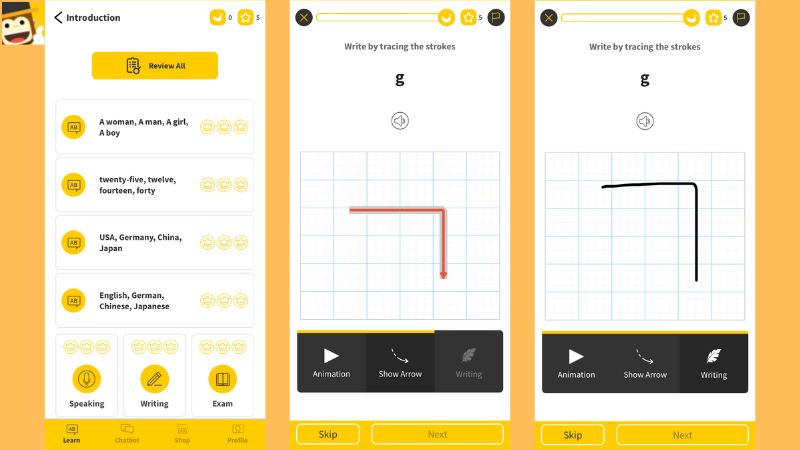As you probably already know, there are four basic language skills: listening, reading, speaking, and writing. Most people think that once you master speaking, you are fluent in the language. That’s definitely not the case!
One study found that employers across 12 different industries said the most important language skill was reading, while employers in only eight industries said the most important language skill was speaking. As you can see, each language skill is valuable, so you must take the time to develop each one as you’re learning Korean adequately.
While we can’t go over how to improve all four language skills here, we’ll share how to improve Korean writing skills in nine valuable tips! So, 배우기 시작하자 (baeugi sijaghaja – “let’s start learning”)!
Tips To Get You Started Improving Your Korean Skills

If you want to learn Korean, you have to know the Korean writing system! Luckily, we’re here to offer you nine tips to improve your Korean writing skills. Do you want to know why we chose nine tips instead of 10? Well, in Korea, they believe 9 is a lucky number!
Tip #1: Make Vocabulary Lists
Of course, you can’t improve your Korean writing skills if you don’t know any vocabulary! In this case, make an effort to learn new vocabulary every day and updated lists of what you’re learning. To help you out, feel free to follow the example below.
“Today, I will learn 10 verbs in Korean.”
- To eat 먹다
- To hate 싫어하다
- To listen 듣다
- To love 사랑하다
- To read 읽다
- To run 달리다
- To speak 말하다
- To talk 이야기하다
- To watch 시청하다
- To write 쓰기
It’s important to remember that you don’t want to rely too heavily on transliterations when you’re learning a character language. You should try early on to learn how to read and speak the vocabulary directly without the help of transliterations!
Tip #2: Set Clear Goals
When you’re learning Korean, make sure to write down your goals. Here are some questions you can ask yourself if you aren’t sure what kind of goals to set.
- What Korean language skills do I want to improve?
- How many new Korean words do I want to learn per month?
- How many hours do I want to dedicate to Korean writing practice?
- How important is sentence structure to me?
There are so many questions you should ask yourself, but remember to be honest with your answers and to set realistic goals. If you don’t have 5 hours per day to spend on Korean writing practice, then don’t put that. However, if you have 1 hour per day to practice, that’s perfectly fine. Distinguish between what you want and what’s achievable.
Tip #3: Assign A Homework To Yourself
Give yourself some homework to finish before your next practice session. If you have a planner, you can note the homework down there, or if not, you can type it somewhere on your phone. The point is, don’t forget!
You don’t have to give yourself a mountain of homework, but just enough to keep your brain engaged with the language and help your memory retain the information better before your next practice. You know what they say, if you don’t use it, you’ll lose it!
Tip #4: Write Regularly
Write, write, and then write some more! When you’re learning a new language, especially one with a complex writing system like Korean, it’s important to keep writing. With Korean, not only do you have to learn the characters, but each character stroke should be written in a certain order.
If you’re not used to characters, this can take time. Be patient with yourself, but remember that the more often you write, the better you’ll become!
Tip #5: Write First, Edit Later (For Total Beginners)
Don’t get so caught up in the mechanics and grammar when you’re writing. If you do, you’ll find yourself with only 1 or 2 sentences written after 30 minutes. That’s not what you want!
As a beginner language learner, it’s important to get as much practice as possible. You can learn grammar and sentence structure later, so immerse yourself in the language and don’t worry about details. After 30 minutes, aim to have 5-10 reasonably comprehensible sentences written down!
Tip #6: Watch Educational Videos
If you’re having trouble with character stroke order, there are tons of resources that can help you! In this case, reading about it probably won’t do much good, so you’ll want to turn to videos, like the thousands available on YouTube, to help you!
When using YouTube, try searching for something like “how to write the Korean alphabet correctly,” and you should get tons of results! You can watch how people write the characters and follow their lead.
Tip #7: Focus On Character Writing
If you want to improve your Korean handwriting, there’s no need to focus on sentence structure, grammar, or complex vocabulary. The only thing that can help you improve your handwriting is practice!
Try to be creative in your language learning when possible! Once you know all 24 letters of the Korean alphabet (14 consonants and ten vowels), you can practice anytime, anywhere! Are you waiting for the bus? Pull out some paper and a pen and keep writing the same letter repeatedly until you’ve mastered it. If you want to have more fun, you can pull up the lyrics to your favorite k pop song and practice your handwriting writing the lyrics. Even better, in the end, you’ll have your very own set of handwritten lyrics.
Tip #8: Ask Someone To Check Your Writing
Once you know the Korean writing system’s basic grammar rules and structure, if you know someone else who’s also learning Korean or you have Korean friends, ask them to check your writing. They’ll be able to give you valuable feedback on what you can improve for next time.
In the case of tip #5, you can ask others to check your writing as well, or you can wait until you’ve learned more before asking others to check.
Tip #9: Experiment With The Language
Don’t be afraid to make mistakes! Keep in mind that learning a new language should be fun, not stressful! Whether you’re learning new Korean words, phrases, grammar rules, or trying to improve your writing skills, remember that, in the end, it’ll all be worth it!
Learning a language is incredibly rewarding. If you put in the time and effort, imagine how happy you’ll be once you’re in South Korea and able to talk with locals! Always remember your end goal and have fun along the way!
Develop Your Writing Skills With The Ling App

If you’re looking for an on-the-go method to learn the Korean language, improve your Korean language skills, or learn another language altogether, it’s time that you use the Ling App! Whether you’re studying Korean at the beginner level or more advanced, Ling has excellent lesson plans for everyone!
Not only does Ling offer Korean and 59+ other languages, but the lessons are comprehensive, structured, and, most importantly, fun! Ling teaches you words and phrases that you can use in daily life, whether meeting up with your Korean friends or talking to a merchant you’ve never met before. The app also includes helpful grammar tips so that you’re learning Korean in the most accurate and best way possible.
Some additional features include audio recordings from native speakers. That way, you can listen to the correct pronunciation of the Korean vocabulary. But, if you want to practice your pronunciation, you don’t want to miss out on Ling’s very own interactive chatbot! The AI chatbot is there to simulate real conversations for you to practice all the new words you’ve learned, plus improve your speaking skills!
In terms of how Ling can help you practice writing, we’ve included some screenshots below to give you an idea!

First, the app previews how the character, or letter in another case, should be written. Next, it places arrows on the order the character should be written in. For example, you wouldn’t start writing the letter “A” from the middle, would you? The last step is to practice on your own and have your writing checked by the app! Easy, right?
Besides the app, Ling has an amazing language blog filled with content related to different languages, countries, cultures, food, and even language tips! If you ever find yourself stuck in a lesson or want to extend your knowledge, all you have to do is refer to the blog!
Do all these features appeal to you? If so, download the app today to start learning with Ling!



































































